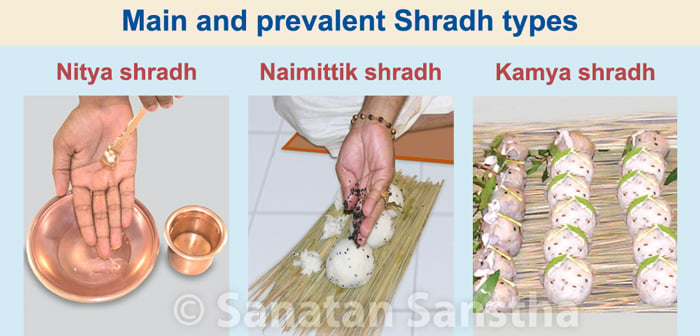
Primarily there are three types of shradhs – Nitya (Everyday), Naimittik (Occasional) and Kamya (Performed with an objective). In addition to these three types, Yamasmruti finds a mention of Nandi shradh and Parvana shradh too as the main types of shradhs.
1. Main and prevalent Shradh days and types
1 A. Nitya shradh
The shradh performed every day is termed as Nitya shradh. This shradh can be performed just by performing tarpan (Offering in a specific way) using water or tarpan using sesame seeds.
1 B. Naimittik shradh
Ekoddishta type of shradhs performed for the pitars fall under Naimittik shradh category.
1 C. Kamya shradh
Shradh performed for achieving a specific objective is termed as Kamya shradh. From the perspective of obtaining fruitful results, if shradh is performed on a specific day, the respective fruitful results are achieved. Their details are given ahead :
Shradh Days and the fruitful results of shradh
| Day | Fruitful results of shradh |
|---|---|
| Monday | Good fortune |
| Tuesday | Victory |
| Wednesday | Fulfilment of desire |
| Thursday | Obtaining knowledge |
| Friday | Acquiring wealth |
| Saturday | Long life |
| Sunday | Health |
1 D. Bhishmashtami shradh
If a couple is not able to have a child or if the wife has frequent abortions, then for the fulfilment of the desire of the well-being of the foetus, perform shradh or tarpan of Bhishmacharya on Bhishmashtami, meaning, on Magha Shukla 8 (Eighth day of the bright fortnight of the month of Magha).
1 E. Nandishradh
The shradh rites that are performed at the commencement of an auspicious ceremony, at the commencement of any of the 16 sanskars like garbhadhan, during a punyahavachan (Recitation of specific mantras for success of a ceremony) is termed as Nandi shradh. In this rite, Satyavasu (or Kratudaksha) are the Vishvedev and three past generations – pitrutrayi (Father, grandfather and great-grandfather), matrutrayi (Mother, grandmother and great-grandmother) and matamahatrayi (Mother’s father, grandfather and great-grandfather) pronounced. Karmanga shradh and Vruddhi shradh are Nandi shradhs.
1 F. Karmanga shradh
This shradh is performed during the sanskar of garbhadhan.
1 G. Vruddhi shradh
This shradh is performed after the birth of a child.
1 H. Parvana shradh
The pindapitru-yadnya (Sacrificial fire for the pitars) mentioned in the Shrout lineage is performed by a Sagnik (He who performs the ritual of Agnihotra regularly). An alternative to this is the Parvana shradh mentioned in the Gruhya sutras. Once the pitars get listed as parvanas, this shradh isperformed for them. Ekaparvana (Single parvana), dwiparvana (Two times parvana), triparvana (Three times parvana) are the three variations of this shradh. Mahalaya shradh and Tirtha shradh are types of Parvana shradh.
-
Mahalaya shradh – This is a Parvana shradh performed on tithis starting from the first day of dark fortnight of Bhadrapad till the new-moon day.
-
Matamaha shradh (Douhitra) – He whose father is alive, but not the mother’s father, should perform this shradh. This shradh cannot be performed before the annual shradh of one’s grandfather. Matamaha shradh can be performed only on Ashwin Shukla Pratipada. The performer should be over 3 years old. He can perform this shradh even if his thread ceremony has not been performed.
-
Tirtha shradh – The shradh performed at Holy places like Prayag or at the banks of a sacred river is termed as Tirtha shradh.
2. Other types of shradh
Apart from the main types mentioned above, there are 96 other types of shradhs namely, 12 Amavasya (New moon day), 4 Yugs (eras), 14 Manvantars, 12 Sankrants, 12 Vaidhruti, 12 Vyatipat, 15 Mahalayas, 5 Pahili, 5 Ashtak and 5 Anvashtake.
Reference : Sanatan Sanstha’s Holy text ‘Shraddha’.

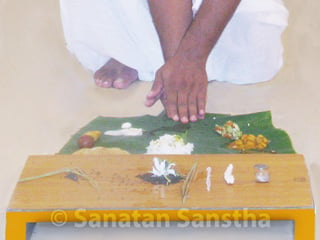
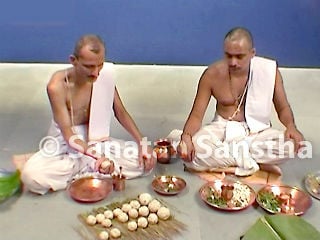 When, where and by whom should Shradh vidhi be performed ?
When, where and by whom should Shradh vidhi be performed ?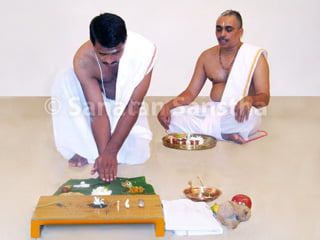 Shradh food
Shradh food Why should we chant ‘Shri Gurudev Datta’ the Name of Lord Datta ?
Why should we chant ‘Shri Gurudev Datta’ the Name of Lord Datta ?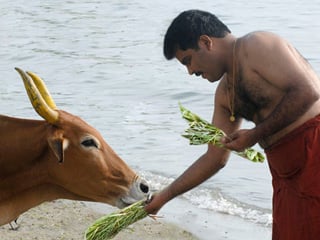 How to do Shradh in case of obstacles
How to do Shradh in case of obstacles Narayan Nagbali and Tripindi shradh
Narayan Nagbali and Tripindi shradh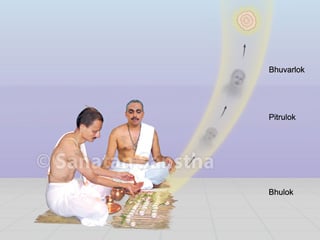 Objectives, Benefits and Importance of Shradh
Objectives, Benefits and Importance of Shradh